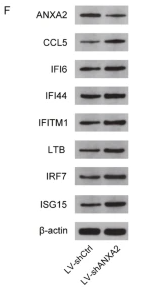| 产品: | IRF7 抗体 |
| 货号: | DF7503 |
| 描述: | Rabbit polyclonal antibody to IRF7 |
| 应用: | WB IHC |
| 文献验证: | WB, IHC |
| 反应: | Human, Mouse, Rat |
| 预测: | Horse |
| 分子量: | 50~70kD; 54kD(Calculated). |
| 蛋白号: | Q92985 |
| RRID: | AB_2841003 |
产品描述
*The optimal dilutions should be determined by the end user.
*Tips:
WB: 适用于变性蛋白样本的免疫印迹检测. IHC: 适用于组织样本的石蜡(IHC-p)或冰冻(IHC-f)切片样本的免疫组化/荧光检测. IF/ICC: 适用于细胞样本的荧光检测. ELISA(peptide): 适用于抗原肽的ELISA检测.
引用格式: Affinity Biosciences Cat# DF7503, RRID:AB_2841003.
展开/折叠
IMD39; Interferon regulatory factor 7; Interferon regulatory factor 7H; IRF 7; IRF 7A; IRF 7H; IRF-7; IRF7; IRF7_HUMAN; IRF7A; IRF7B; IRF7C; IRF7H;
抗原和靶标
- Q92985 IRF7_HUMAN:
- Protein BLAST With
- NCBI/
- ExPASy/
- Uniprot
MALAPERAAPRVLFGEWLLGEISSGCYEGLQWLDEARTCFRVPWKHFARKDLSEADARIFKAWAVARGRWPPSSRGGGPPPEAETAERAGWKTNFRCALRSTRRFVMLRDNSGDPADPHKVYALSRELCWREGPGTDQTEAEAPAAVPPPQGGPPGPFLAHTHAGLQAPGPLPAPAGDKGDLLLQAVQQSCLADHLLTASWGADPVPTKAPGEGQEGLPLTGACAGGPGLPAGELYGWAVETTPSPGPQPAALTTGEAAAPESPHQAEPYLSPSPSACTAVQEPSPGALDVTIMYKGRTVLQKVVGHPSCTFLYGPPDPAVRATDPQQVAFPSPAELPDQKQLRYTEELLRHVAPGLHLELRGPQLWARRMGKCKVYWEVGGPPGSASPSTPACLLPRNCDTPIFDFRVFFQELVEFRARQRRGSPRYTIYLGFGQDLSAGRPKEKSLVLVKLEPWLCRVHLEGTQREGVSSLDSSSLSLCLSSANSLYDDIECFLMELEQPA
种属预测
score>80的预测可信度较高,可尝试用于WB检测。*预测模型主要基于免疫原序列比对,结果仅作参考,不作为质保凭据。
High(score>80) Medium(80>score>50) Low(score<50) No confidence
研究背景
Key transcriptional regulator of type I interferon (IFN)-dependent immune responses and plays a critical role in the innate immune response against DNA and RNA viruses. Regulates the transcription of type I IFN genes (IFN-alpha and IFN-beta) and IFN-stimulated genes (ISG) by binding to an interferon-stimulated response element (ISRE) in their promoters. Can efficiently activate both the IFN-beta (IFNB) and the IFN-alpha (IFNA) genes and mediate their induction via both the virus-activated, MyD88-independent pathway and the TLR-activated, MyD88-dependent pathway. Induces transcription of ubiquitin hydrolase USP25 mRNA in response to lipopolysaccharide (LPS) or viral infection in a type I IFN-dependent manner (By similarity). Required during both the early and late phases of the IFN gene induction but is more critical for the late than for the early phase. Exists in an inactive form in the cytoplasm of uninfected cells and following viral infection, double-stranded RNA (dsRNA), or toll-like receptor (TLR) signaling, becomes phosphorylated by IKBKE and TBK1 kinases. This induces a conformational change, leading to its dimerization and nuclear localization where along with other coactivators it can activate transcription of the type I IFN and ISG genes. Can also play a role in regulating adaptive immune responses by inducing PSMB9/LMP2 expression, either directly or through induction of IRF1. Binds to the Q promoter (Qp) of EBV nuclear antigen 1 a (EBNA1) and may play a role in the regulation of EBV latency. Can activate distinct gene expression programs in macrophages and regulate the anti-tumor properties of primary macrophages.
Acetylation inhibits its DNA-binding ability and activity.
In response to a viral infection, phosphorylated on Ser-477 and Ser-479 by TBK1 and IKBKE1. Phosphorylation, and subsequent activation is inhibited by vaccinia virus protein E3. In TLR7- and TLR9-mediated signaling pathway, phosphorylated by IRAK1.
TRAF6-mediated ubiquitination is required for IRF7 activation.
Sumoylated by TRIM28, which inhibits its transactivation activity.
(Microbial infection) Cleaved and inactivated by the protease 3C of enterovirus 71 allowing the virus to disrupt the host type I interferon production.
(Microbial infection) Cleaved and inactivated by the protease 3C of human enterovirus 68D (EV68) allowing the virus to disrupt the host type I interferon production.
Nucleus. Cytoplasm.
Note: The phosphorylated and active form accumulates selectively in the nucleus.
Expressed predominantly in spleen, thymus and peripheral blood leukocytes.
Monomer. Homodimer; phosphorylation-induced. Heterodimer with IRF3. Interacts with TICAM1 and TICAM2. Interacts with MYD88 AND TRAF6.
(Microbial infection) Interacts with Epstein-Barr virus LF2 and LMP1.
(Microbial infection) Interacts with rotavirus A NSP1; this interaction leads to the proteasome-dependent degradation of IRF7.
(Microbial infection) Interacts with human herpes virus 8/HHV-8 proteins ORF45 and vIRF-1.
(Microbial infection) Interacts with human T-cell leukemia virus 1/HTLV-1 protein HBZ.
(Microbial infection) Interacts with Seneca Valley virus protease 3C; this interaction is involved in the suppression of IRF7 expression and phosphorylation by the virus.
Belongs to the IRF family.
研究领域
· Human Diseases > Infectious diseases: Viral > Hepatitis C.
· Human Diseases > Infectious diseases: Viral > Hepatitis B.
· Human Diseases > Infectious diseases: Viral > Measles.
· Human Diseases > Infectious diseases: Viral > Influenza A.
· Human Diseases > Infectious diseases: Viral > Herpes simplex infection.
· Human Diseases > Cancers: Overview > Viral carcinogenesis.
· Organismal Systems > Immune system > Toll-like receptor signaling pathway. (View pathway)
· Organismal Systems > Immune system > NOD-like receptor signaling pathway. (View pathway)
· Organismal Systems > Immune system > RIG-I-like receptor signaling pathway. (View pathway)
· Organismal Systems > Immune system > Cytosolic DNA-sensing pathway. (View pathway)
文献引用
Application: IHC Species: Mouse Sample: lung tissue
Application: WB Species: Mouse Sample:
Application: WB Species: mouse Sample: lung
Application: WB Species: Human Sample: HK2 cells
限制条款
产品的规格、报价、验证数据请以官网为准,官网链接:www.affbiotech.com | www.affbiotech.cn(简体中文)| www.affbiotech.jp(日本語)产品的数据信息为Affinity所有,未经授权不得收集Affinity官网数据或资料用于商业用途,对抄袭产品数据的行为我们将保留诉诸法律的权利。
产品相关数据会因产品批次、产品检测情况随时调整,如您已订购该产品,请以订购时随货说明书为准,否则请以官网内容为准,官网内容有改动时恕不另行通知。
Affinity保证所销售产品均经过严格质量检测。如您购买的商品在规定时间内出现问题需要售后时,请您在Affinity官方渠道提交售后申请。产品仅供科学研究使用。不用于诊断和治疗。
产品未经授权不得转售。
Affinity Biosciences将不会对在使用我们的产品时可能发生的专利侵权或其他侵权行为负责。Affinity Biosciences, Affinity Biosciences标志和所有其他商标所有权归Affinity Biosciences LTD.




